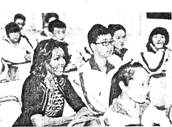We go to school every day to become a better
person. So how can we become powerful and start
changes in our own life? Perhaps we can get tips from the US
First Lady Michelle Obama. During her 'visit to China, from March 20-26, Mrs. Obama shared her views on education and youth empowerment with students.
The first lady encouraged Chinese students to aim high and get a good education* In Chengdu No. 7 High School, she told students that having humble (贫寒的) roots doesn't matter as long as you have perseverance(毅力)
Mrs. Obama said her family was not rich. Like many Chinese students, her parents had big dreams for her. She felt the weight of her parents' sacrifices(牺牲) on her shoulders and worked hard to make them proud. Persevering was not easy, though. Sometimes she had to wake up at 4:30 am and study late into the night. "But whenever I got tired or discouraged(气馁 WJ)... I would remember something my mother. always told me. She said: 'A good education is something that no one cart take away from you.''
Mrs. Obama also encourages Chinese students to study abroad to broaden their horizons(开阔眼界) in her speech at Peking University. "As the Chinese saying goes: It is better to travel 10,000 miles than to read 10,000 books," she said. It's not enough to get good grades in school. It's also important to have real experience with languages, cultures and societies different from your own, she noted.
Studying overseas could also benefit future international relations. It could help young people from different countries work together to deal with shared problems such as climate change, Mrs. Obama said.

小题1:From the first paragraph , what kind of views did Mrs. Obama share with the students ?
| A.education and development |
| B.empowerment and perseverance |
| C.education and youth empowerment |
| D.education and youth perseverance |
小题2:From the last paragraph, what is the meaning of the word "benefit"?
| A.be good at | B.be good with |
| C.be bad for | D.be good for |
小题3:From the passage ,we can learn that
| A.Michelle Obama lived a rich life when she was young . |
| B.Michelle Obama worked hard to make her parents proud.. |
| C.Michelle Obama sometimes had to wake up at 4:30 pm and study late into the night. |
| D.Michelle Obama would remember something her teachers always told her whenever she got tired or discouraged. |
小题4:Which of the following is NOT true according to the passage?
| A.The first lady encourages Chinese students to aim high and get a good education. |
| B.The first lady thinks it terrible for students to have humble roots . |
| C.The first lady thinks that a good education is something that no one can take away from you. |
| D.Mrs. Obama encouraged Chinese students to study abroad to broaden their horizons. |
小题5:Which of the following is TRUE according to the passage?
| A.We can get tips from the US First Lady Michelle Obama during her visit to Beijing No. 7 High School |
| B.It's wonderful enough for students to get good grades only in school. |
| C.It's not important to have real experience with languages, cultures and societies different from your own. |
| D.Studying overseas could help young people from different countries work together to deal with shared problems. |